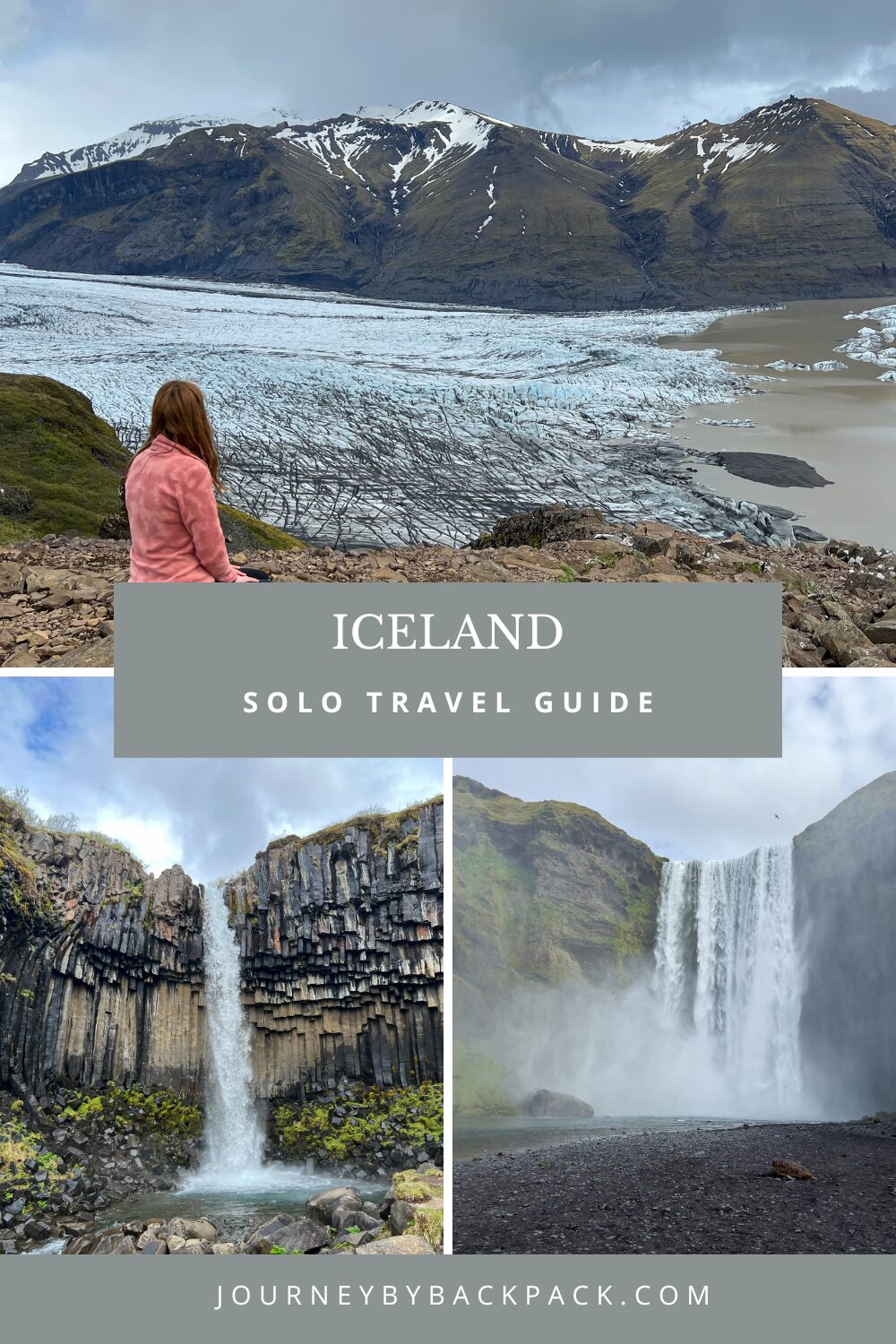Solo Female Travel in Iceland: Updated Guide & Helpful Tips
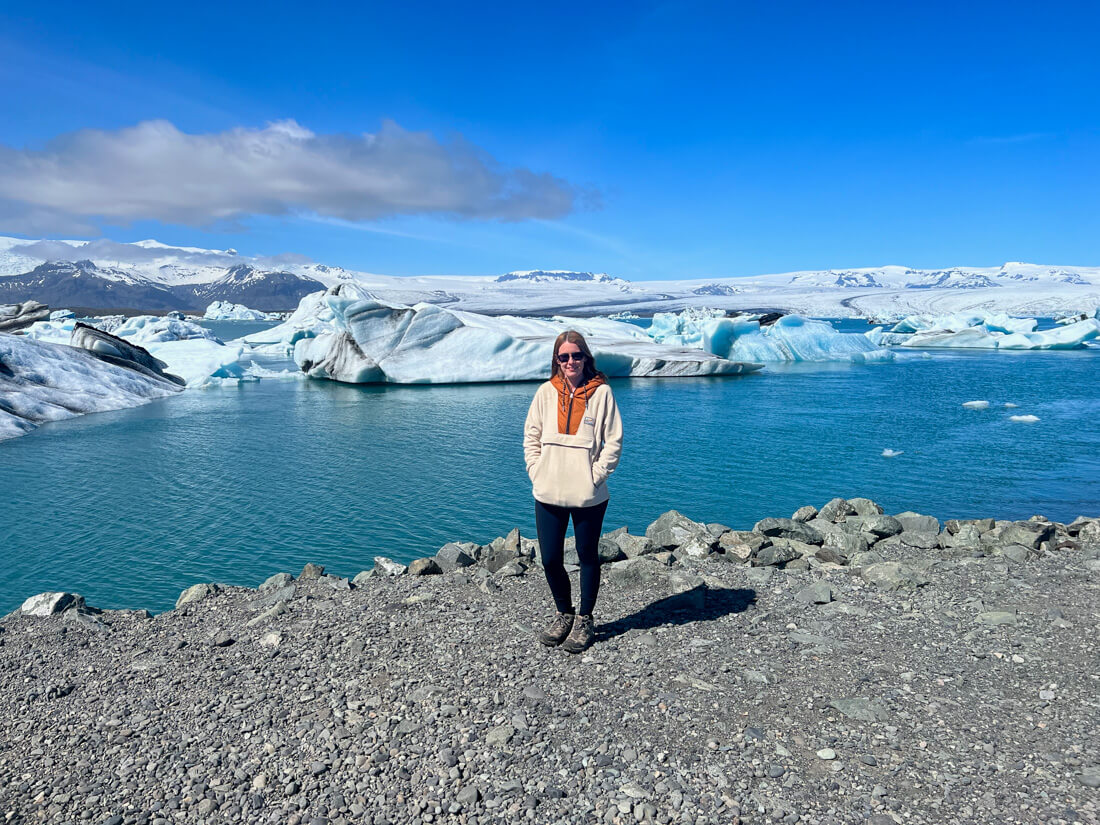
Fondly nicknamed the Land of Fire and Ice, Iceland is like nowhere else on Earth. It is filled with rugged landscapes, black sand beaches, beautiful waterfalls, epic volcanoes, and magnificent glaciers.
Iceland is constantly growing in popularity, and it’s becoming a popular destination for a solo adventure. Thankfully, Iceland is one of the safest destinations in the world for solo female travellers. Despite being a great place to explore alone, it does require some planning and preparation.
I’ve visited Iceland twice now, and I’m currently planning a third. On my second, I drove around the Iceland Ring Road by myself for two weeks. I can’t pretend I wasn’t a little nervous to be alone on this big adventure, but all my solo travel worries quickly disappeared, and it turned out to be one of my favourite trips EVER.
In this guide, I’ve shared everything you need about a solo trip to Iceland. I hope you find it useful.
Is Iceland safe for solo female travel?
Nowhere in the world can ever be 100% safe, but it doesn’t get much better than Iceland. According to the Global Peace Index, Iceland is the safest country on Earth, making it a great place for a solo female trip. This means you can put your solo travel fears aside and focus on having the trip of a lifetime.
Although Iceland is generally considered very safe for solo travellers, it’s still important to be prepared, follow some basic guidelines and avoid taking any risks. I’ve spoken more about this below.
Iceland might also not be the best destination for a first solo trip. This is mainly due to the long journeys, the isolated destinations and the lack of a backpacker community. Having said that, if you’re not worried about driving (or planning to join tours) and not expecting the trip to be social, then Iceland is as good as it gets for a first-time solo trip.

Reasons to solo travel in Iceland
There are so many reasons to choose Iceland for a solo trip. Aside from being one of the safest countries on earth, it’s filled with incredible landscapes and promises to be an adventure.
Here are a few of the reasons to consider a solo trip to Iceland:
- It’s an adventure: If there’s one thing you can guarantee about a trip to Iceland, it’s that it will be an adventure. With extreme weather, dramatic landscapes and unique wildlife, you never quite know what’s waiting for you in Iceland.
- You can explore at your pace: One of the best parts of solo travel is being able to explore at your own pace, and a solo trip to Iceland is no different. There is so, so much to see in Iceland, and it will be impossible to see everything. However, when you’re alone, you can decide exactly how you want to spend your time.
- It’s safe: Iceland is one of the safest countries in the world. Crime rates are very low in Iceland, and the locals are very big on gender equality. I never once felt unsafe in Iceland.
- It’s a liberating experience: I don’t think I’ve ever quite felt as free as I did on my road trip around Iceland. It was just me and the open road, and I loved being able to adapt my itinerary when I came across something interesting (which was all the time!).
- There is so much to do: Iceland is filled with unique and exciting things to do. Swim between tectonic plates, hike on a glacier, explore an ice cave, see a plane wreck, climb behind waterfalls, and witness the northern lights (Aurora Borealis). Even if you’re alone in Iceland, you’ll never run out of things to do.

Disadvantages of solo travel in Iceland
While Iceland is a fantastic destination for solo travellers, it doesn’t come without its challenges. Here are a few of the downsides.
- It’s expensive: Iceland is expensive (whether or not you visit as a solo traveller). However, solo travel in Iceland can be more expensive than travelling with someone else. If you plan to hire a car or stay in private rooms, you’ll need to cover the cost by yourself rather than splitting it with someone else.
- Quiet backpacker scene: If you’re planning to backpack in Iceland, you might find the hostels to be on the quieter side compared to other countries. As Iceland is very expensive, it’s not the most appealing destination for backpackers. However, I don’t think it’s the type of country you go to for partying or to meet people, so it didn’t bother me.
- There are long drives: If you’re planning a road trip through Iceland, you’ll face some long drives. Doing all of this driving by yourself can be exhausting. I drove around the entire ring road by myself. One day, I drove for nine hours. While there were plenty of stops along the way, it was still exhausting.
Tips for solo travel in Iceland
Choose the right time of year
You can visit Iceland at any time of the year, but certain activities or attractions can only be seen during specific periods.
Generally speaking, the summer season is the most popular time to visit Iceland. Thanks to the very long daylight hours, accessible roads and favourable weather conditions, this is the most popular time of year to visit.
On the other hand, the winter months in Iceland come with short daylight hours, extreme weather and potentially dangerous driving conditions. However, it’s the best time to see the northern lights and explore Iceland’s incredible winter landscape.

Honestly, I don’t think there’s a wrong time to visit Iceland. It all comes down to exactly what you want to see. Here’s a quick summary:
- If you want to do a road trip around the ring road, visit between May and September.
- For long days with warmer weather, visit between June and August.
- To see the Northern Lights and ice caves, visit Iceland between October and March.
- If you want to see Iceland’s wintery landscape, opt for January or February.
In my opinion, the best time to visit Iceland is in the shoulder seasons (spring & autumn). This is the months of April to June and September & October.
I’ve visited the country in both May and October which are part of the ‘shoulder season’ – the weather is ideal but it’s not too crowded. Most places on the ring road are accessible at this time. Although, you may find the country’s ‘F Roads’ unaccessible (gravelled roads taking you into Iceland’s highlands).
It’s worth noting that good weather is never guaranteed in Iceland. Even in the summer, there can be snow and extreme winds.

Plan your accommodation in advance
It’s a good idea to book your accommodation in advance, especially when visiting in the summer months.
Iceland is becoming more and more popular each year. In the peak season, finding last-minute accommodation can be tricky and expensive.
When I visited in May, I booked all my accommodation about one month ahead and struggled to find things within my budget.
The downside of booking ahead means you have no flexibility with your itinerary, but prices shot up as my trip got closer, so I really had no choice. For some accommodation inspiration, here are 16 great Iceland ring road hotels.
If you want more flexibility, I’d recommend hiring a campervan in Iceland.
Choose how to get around Iceland
One of the best ways to see Iceland is to hire a campervan or car. This gives you the freedom to go anywhere you please and avoid the need to join day tours.
Driving on Iceland’s roads can be a scary prospect, but the main ring road is very well maintained. The main issue you could face is extreme weather, such as snow, ice, and wind. For what it’s worth, I was terrified about driving alone in Iceland, but it was absolutely fine.
If you’re not keen on a solo road trip, you have two other options:
- Base yourself in Reykjavik and do organised day trips
- Join a small group tour
Reykjavik is a fantastic place to base yourself in Iceland if you don’t have a car. From here, there are so many day trips to popular destinations in Iceland. This includes the Golden Circle Tour, the South Coast and even the famous Glacier Lagoon.
There is also the option to join a small group tour. I love group tours! They’re a fantastic way for solo travellers to explore a destination without worrying about being alone.
There are several tour operators in Iceland that cover the main attractions, as well as off-the-beaten-path destinations. The Iceland tours are pretty expensive, but that just reflects the country. One of my favourite small group tour operators is G Adventures. They offer a range of itineraries in Iceland throughout the year, and they’re a popular choice for solo female travellers.
I’ve spoken more about group tours in Iceland further down this post.
Unfortunately, Iceland’s public transport system isn’t great. You can get around Reykjavik and between some of the major towns in south Iceland, such as Selfoss, but beyond that, there aren’t many options. I wouldn’t advise relying on public transport.
Another popular way to get around Iceland is to hitch hike. This isn’t something I have personally ever done, but it’s a very common sight when you drive around Iceland.

Know the rules of the road
If you’re planning a road trip in Iceland, it’s important to know the rules of the road. When you’re travelling alone, you won’t have anyone to check something for you while you’re driving.
The RAC has a great resource discussing the various driving rules in Iceland.
One of Iceland’s most unique driving laws is that vehicle headlights must be on while driving. Even if it’s 1 p.m. on a sunny afternoon, those headlights must be turned on. I assume this is due to the country’s unpredictable and quick-changing driving conditions.
If you don’t follow this rule, you may even be fined, so make sure those headlights are switched on.
Carry a little bit of cash
It’s a good idea to carry at least a little cash. Most places in Iceland accept debit or credit cards (and even prefer them), but there may be occasions when you need to use cash. I found this to be true when I wanted to do laundry or when card machines weren’t working.
ATMs are available at the airport and in most of the bigger towns. You can also order it ahead of your trip in most countries.

Wake up early (or stay up late)
When travelling solo in Iceland, you have complete freedom over your itinerary. This means you can do exactly what you want and when you want.
It’s fair to say the natural wonders of Iceland draw in the crowds. And by crowds, think multiple coaches full of hundreds of people. This is especially true for the Golden Circle and some of the South Coast.
If you’re visiting Iceland from May to September, you can make use of the long daylight hours. To avoid the hordes of people in the south and the Golden Circle, utilise the daylight as much as possible and visit places early in the day or late at night.
During my trip, I set off most days at 6 a.m. Yes, it was exhausting, but it meant I got to see these wonders of nature without hundreds of other people.
I visited the iconic Kirkjufell Mountain at 9 p.m. and was one of only a handful of people there. Even better, when I visited the gorgeously beautiful Stokksnes Beach in the evening, I had the entire place to myself. My jaw dropped!
If you hire a campervan on your solo trip to Iceland, you could even consider sleeping during the day and travelling during the night. During the summer months, the sun barely sets, meaning there is almost 24/7 daylight.
Tip: Always check the opening times of any attractions. Most of Iceland’s natural attractions are accessible 24/7, but it’s worth double-checking.

Be prepared for all types of weather (in a single day)
Iceland has very inconsistent weather, which can be very unpredictable. You can experience all four seasons in a day or even in the space of a few hours. It’s essential to be prepared for any weather in Iceland.
Within one hour, I went from a heavy snowstorm to bright sunshine. By the afternoon, wind and rain came out of nowhere.
If you’re planning solo hikes, always carry extra layers and a waterproof jacket. This will help to ensure you are prepared for any weather that Iceland throws at you.
I’d also advise checking the Iceland Safety App every day. This helpful app shares any weather warnings or dangerous road conditions. It’s useful for all travellers to Iceland, but especially solo travellers who are navigating everything alone.
Plan your budget
It’s well-known that Iceland is expensive. While it is possible to visit Iceland on a budget, it’s by no means the cheapest destination in the world.
Solo travel in Iceland is more expensive than visiting with someone else. You’ll need to cover the cost of everything from the rental vehicle to your accommodation completely by yourself.
Before embarking on a solo trip to Iceland, I suggest researching the costs of things and planning a budget. This will allow you to be fully prepared for the high costs and not arrive in Iceland to realise you can’t afford food. If you’re hiring a car, remember to consider the cost of fuel.

Knowing your budget will allow you to plan your accommodation, activities and food options accordingly.
I’d recommend budgeting more than you think you’ll need. This way, you won’t be caught off guard if something goes wrong.
Keep that car tank full
If you’ve hired a vehicle and you’re heading to the north of the country or into the highlands, make sure your fuel tank is full. Fill it up at every opportunity. You can drive for hours without a gas station.
Tip: Many fuel pumps are self-service single pumps at the side of a road rather than a regular gas station.
Most of Iceland’s petrol stations can be found on Google Maps.
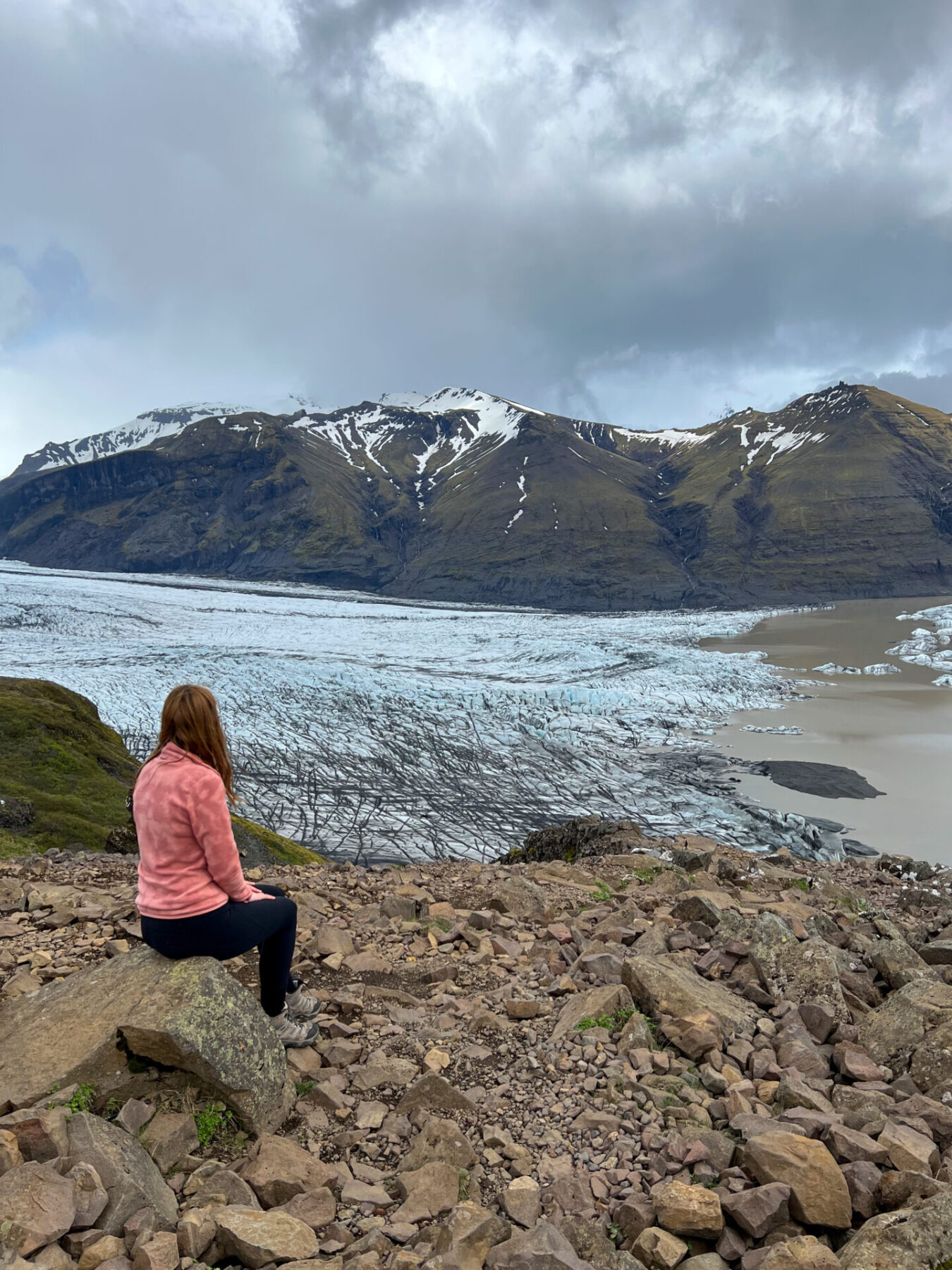
Stay connected and keep in touch with your friends and family
Wherever in the world you travel solo, it’s a good idea to keep in touch with your family and friends. I recommend always letting someone know where you are. If you go on a solo hike or somewhere without a signal, let a friend know in advance. This way, someone knows your last location.
If you’re travelling alone and your phone doesn’t have a working SIM Card, it’s worth investing in a pocket Wi-Fi device for the car. Most Icelandic car rental companies include this as an optional extra.
The roads in Iceland can become very isolated away from the main tourist hot spots, and you want to be able to stay connected in case something goes wrong.
I had a Wi-Fi device in the car, as the car hire company provided it for free. At times, it didn’t work in the mountains, but it was generally helpful. Solo travel in Iceland is a fantastic experience, but staying connected is important for your safety.
Download maps offline
Phone service in Iceland can be very patchy, especially in the country’s north. As a solo traveller in Iceland, the last thing you want to do is get lost alone. To avoid this, I suggest downloading an offline version of a map of Iceland.
Google Maps is a great way to do this. If you lose signal, you can still navigate using Google Maps. It’s important to download the maps in advance when you’re on WiFi.
Most car hire companies offer the option to rent a satellite navigation or GPS device. However, this can come with a hefty price tag. I found offline Google Maps a great way to get around Iceland, along with my pocket WiFi device for emergencies.
Most car rental companies also provide a physical paper map. These can be useful if you get really stuck!
If you plan to hike solo, you can download the trail offline using AllTrails.
READ NEXT: The Ultimate Guide to Visiting Lake Myvatn
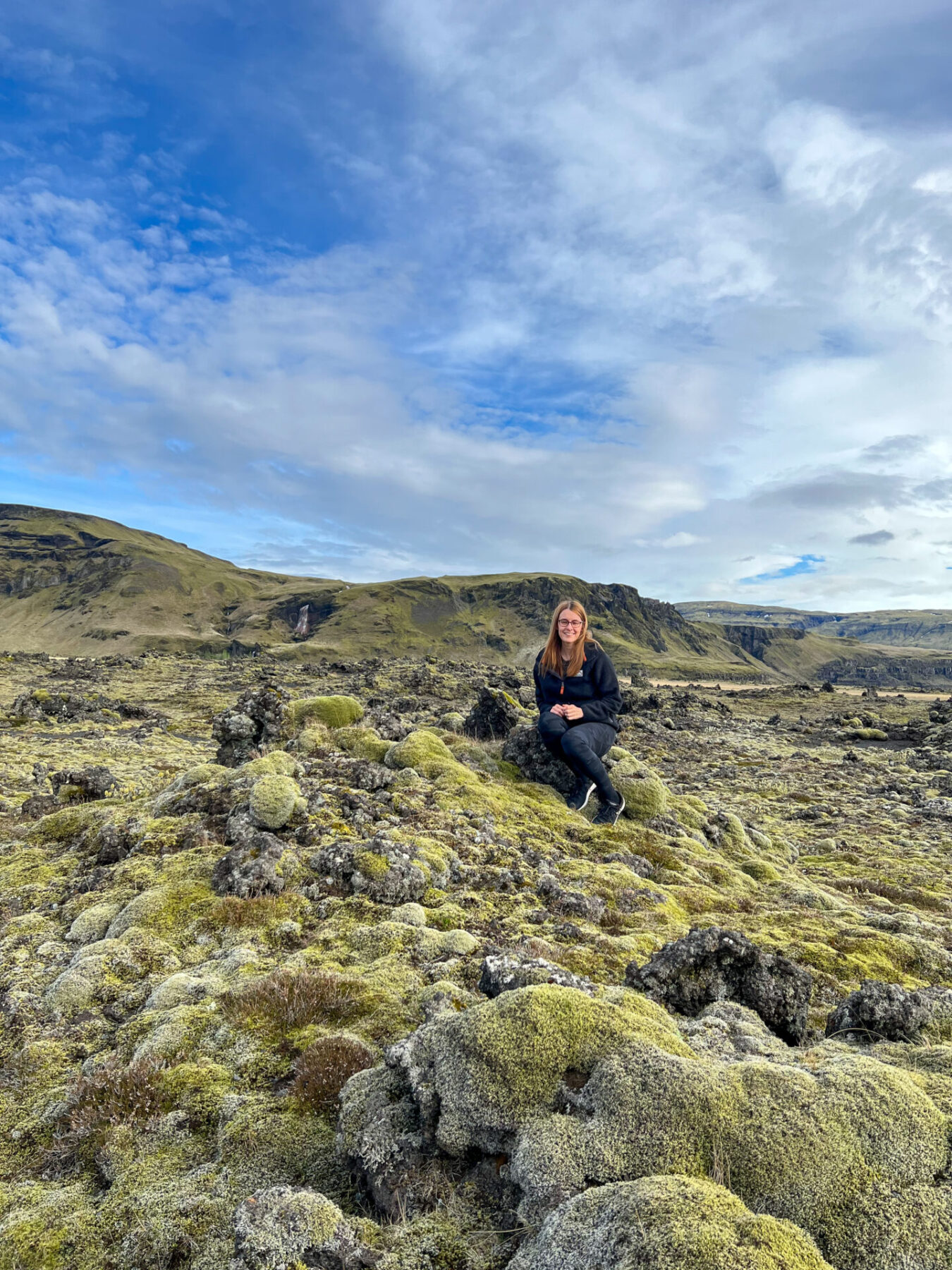
Plan your day, but don’t over-plan
One of the beauties of an Icelandic road trip is how unpredictable it can be. You can have all your plans laid out for the day but then spot something as you drive that changes that.
The truth is that Iceland is filled with natural marvels that aren’t included on internet itineraries. My favourite part about driving around Iceland was not knowing what I would find around each corner. Whether it be a stunning viewpoint, a hidden black sand beach, giant lava fields or a beautiful unnamed waterfall, Iceland is full of hidden gems.
When planning a solo trip to Iceland, have a rough idea of what you want to do daily. This includes pre-booking any activities you want to do. However, don’t overplan your trip.
The beauty of solo travel is having the flexibility to change your plans and do what you want. Allow time each day to discover things that you haven’t planned.
This is especially true when doing a solo road trip in Iceland. On the day I drove the Eastern Fjords, I expected it to take around seven hours with a few stops. It turned out to be a twelve-hour drive. There were so many incredible places to stop for some of the most epic views.
Watch out for animals on the road
Animals tend to roam freely in Iceland, especially horses, sheep, and reindeer. You’ll likely come across some free-roaming animals during your Iceland solo trip, especially when driving in the north.
Keep an eye out for animals when driving. They can come out of nowhere, and there are many accidents involving animals on the road. It’s also worth checking that your vehicle insurance covers animal collisions. This is often sneakily only included on the premium versions.
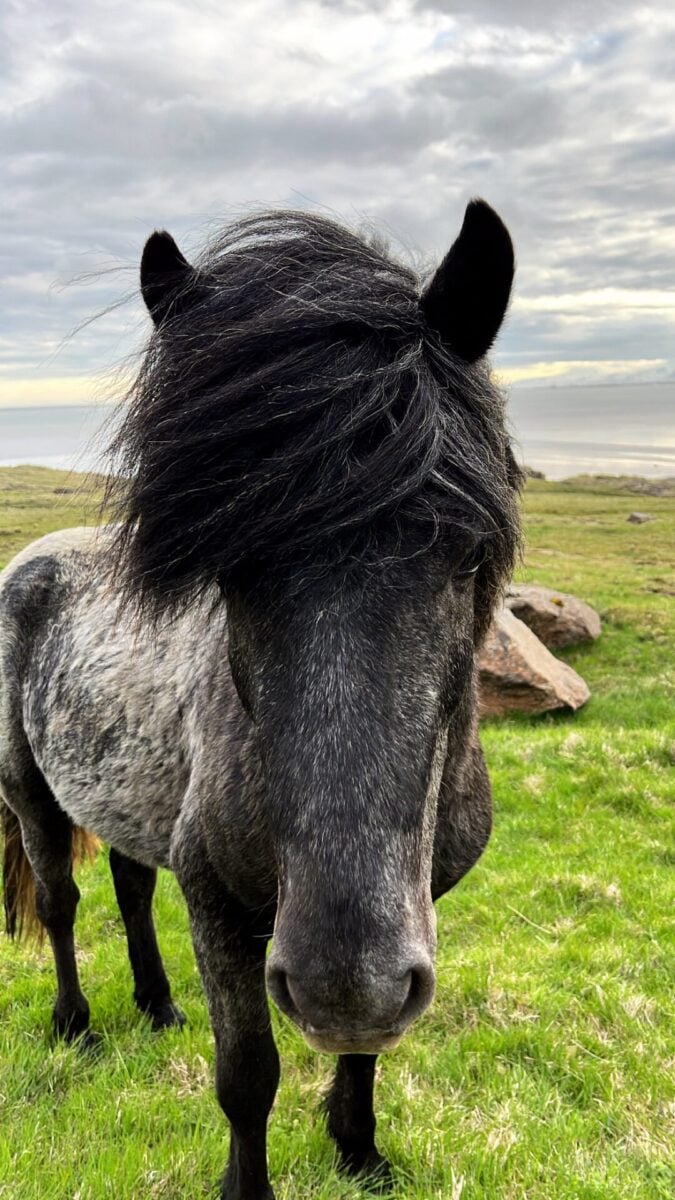
Download a playlist or a podcast
There are some LONG driving days in Iceland, especially if you’re driving around the entire ring road. If you’re travelling solo to Iceland, have some music or a podcast downloaded to keep you entertained on the drives.
Ensure these are downloaded in advance so you’re all prepared for your trip.
My iPhone connected to my rental car via its regular USB charging cable, which allowed me to play music through the car’s system easily.
Know your limits
It’s important to know your limits whenever embarking on a solo trip. This is especially true if you’re doing a solo road trip in Iceland.
You’re entirely responsible for yourself, which is great, but it also means you must look after yourself.
If you’re driving the ring road alone, know what you’re comfortable with. For example, are you happy to drive in the dark? Are you confident driving in extreme weather? Testing these things is not a good idea when you’re by yourself. Know and trust your limits.
The same is true when hiking solo in Iceland. If you have any doubts about your abilities to complete the hike, question if it’s the right thing to do. I’m a full supporter of solo travel and hiking, but looking after yourself is important.
Solo travel in Iceland is a fantastic experience. It’s a great time to push yourself out of your comfort zone. However, do this responsibly and safely.
Talk to locals
The locals in Iceland are very friendly. While Icelandic is the main language, English is widely spoken.
If you have any problems in Iceland, don’t hesitate to ask the locals. They know the country better than anyone and should be able to help you.
I got my car stuck in volcanic ash (long story), and a local came to help me get out. They were so friendly and helpful. If I hadn’t asked, who knows how long I would have been stuck there.
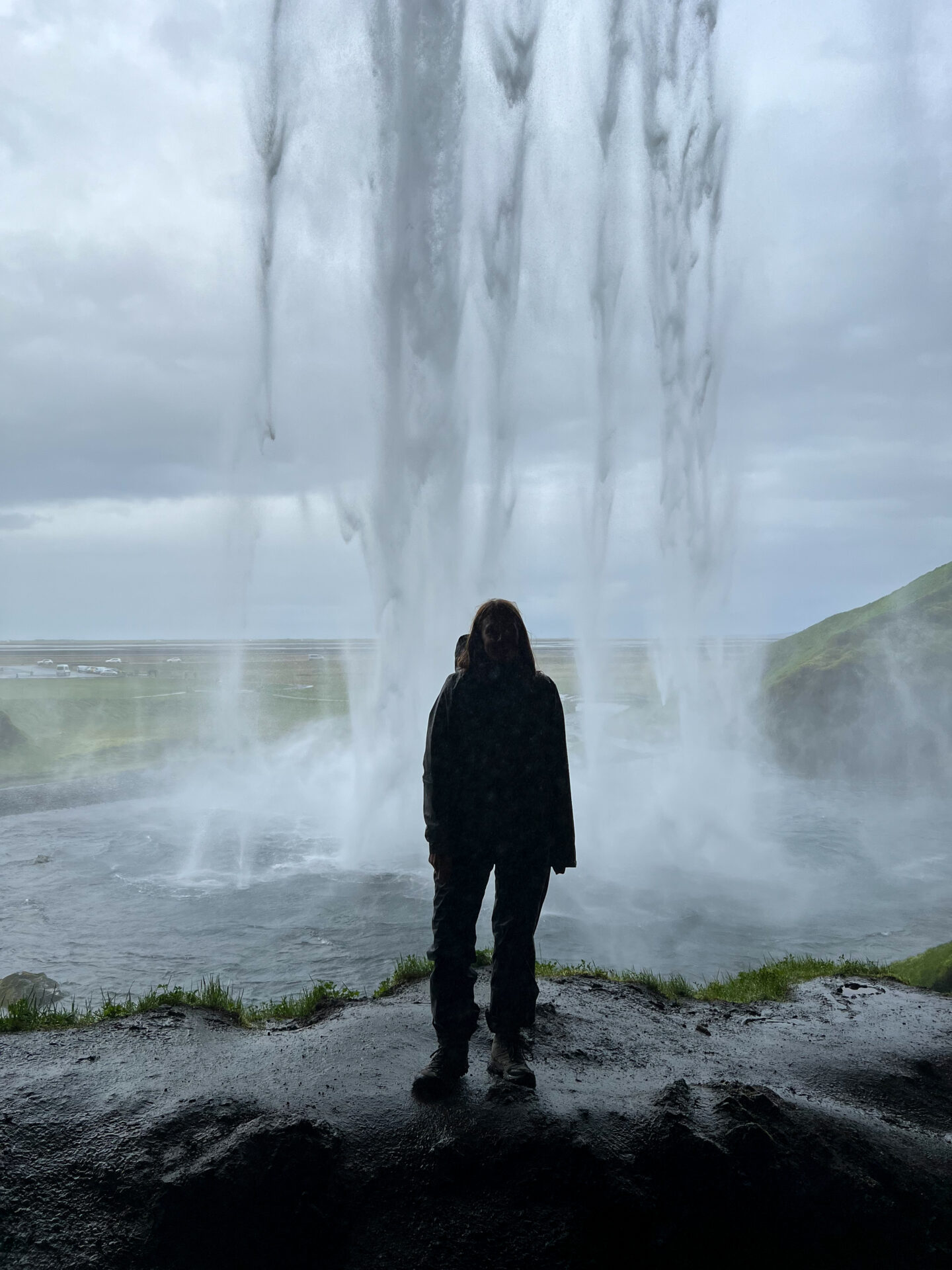
Have travel insurance
Ensure you’re covered for all eventualities for your solo trip to Iceland. If you’re hiring a car, having the right car insurance is important. This is true for any road trip, but when you’re alone, you’ll be left to cover any costs yourself. Having the right insurance could save you A LOT of money.
In Iceland, most rental companies offer their own insurance, which is usually the best option. I got a chipped windscreen on my road trip, and they didn’t even question it when I returned it. I had taken out their premium insurance.
General travel insurance is also very important for any trip. When it comes to Iceland, I’d suggest choosing insurance that covers natural disasters. Iceland is no stranger to earthquakes and volcanic activity. It’s surprising how many travel insurance policies subtly exclude this from their coverage.
My favourite travel insurance is True Traveller. You can cover as much or as little as you like. It also covers backpackers and one-way travel and will cover you if you’re already abroad. I had to claim with them once and had the money in my bank account within 24 hours. (PS—I don’t receive any benefit for mentioning them; I just genuinely think they’re a great insurance company!).

Useful apps for solo travel in Iceland
Be prepared for your solo trip to Iceland by downloading these useful apps before your visit.
- Safety.is: This is the most important app to have for a solo trip in Iceland. This app shares all the latest safety news such as extreme weather, road closures and volcanic activity. It’s important to check every day.
- AllTrails: This is my favourite hiking app. It allows you to \ research hikes in advance and download a trail map to use offline.
- Vedur: This is a great weather app. Extreme weather conditions are common in Iceland, so always check the weather forecast before embarking on any solo activities.
- Aurora forecast: If you’re hoping to catch the Northern Lights, download the Aurora Forecast app. This will tell you the chances you have of seeing them, when they will be at their strongest and the best places to be.
Group tours in Iceland
If you’re nervous about travelling solo in Iceland, consider joining a group tour. Small group tours are a fantastic way to meet new people and reduce the stress of travel.
There are a few options for group tours in Iceland. One of my favourite group travel companies for solo travellers is G Adventures. This fantastic company offers group tours worldwide, with several options for Iceland.
G Adventures offers tours in both the winter and summer. In addition to covering the main attractions, there are a couple of tours that take you off the beaten path on hiking adventures and to hidden hot springs.
For something a little bit different, consider looking at Much Better Adventures who offer various hiking adventures around Iceland.
I’ve participated in over ten group tours around the world. I’ve also been a group leader for a large group tour company. They are a fantastic way to travel as a solo traveller. If you have any fears about joining a group trip solo… do it! In my experience, most people who join group tours are solo travellers.
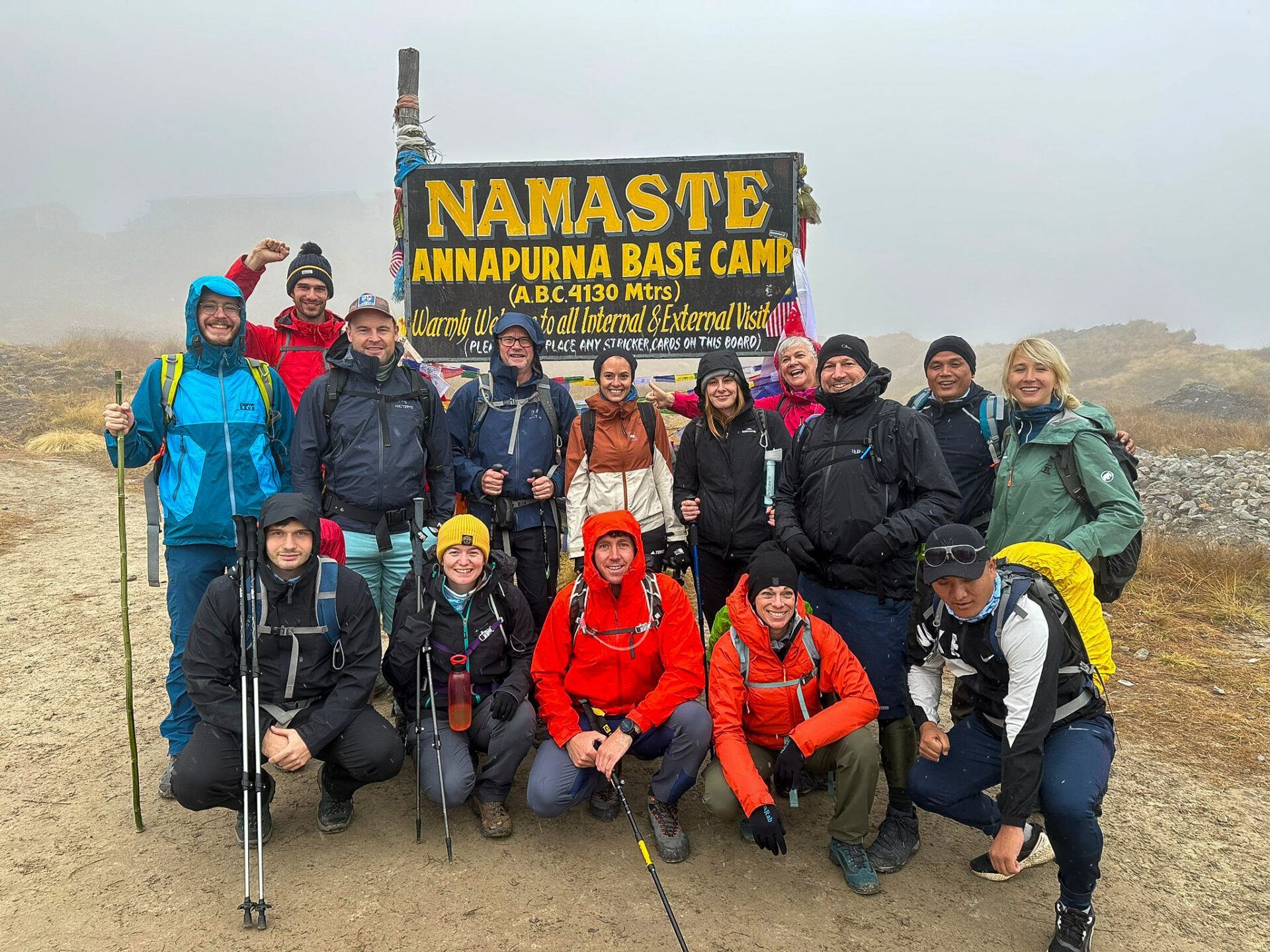
Hostels in Iceland
If you’re travelling solo in Iceland, staying in hostels is the most affordable way to travel (other than camping).
While Iceland has an amazing selection of hostels, they are slightly different from some countries I’ve travelled to. For starters, they’re very expensive. Arguably some of the most expensive in the world.
Iceland’s hostels also tend to be much quieter. Most people go to Iceland to spend their days exploring, which means the hostels aren’t always the most social places during the evening. While they’re still good for meeting people, be prepared to find hostels a little bit quieter in Iceland. It’s a very different experience compared to the hostels of Southeast Asia.
Hostels are still a fantastic option. It’s just important to go in with the right expectations.
Here are some of my favourite hostels in Iceland:
- The Loft Hi Hostel is a fantastic option for Reykjavik’s capital city. It’s one of the only hostels I could find that has a place to lock away valuables. While Iceland is very safe, that’s not to say crimes can’t or won’t occur. Better safe than sorry, in my opinion!
- Kex is another excellent option and one of the first hostels I ever stayed in.
- Consider the Selfoss Hostel or the Midgard Basecamp for hostels in the Golden Circle.
- If you’re heading to the north of Iceland, the Hafnarstraeti Hostel is a good option. It offers pod-style beds with plenty of privacy.
Tip: You may find that smaller guesthouses are priced similarly to hostels. If you’re looking at hostels, I’d widen your search to include guesthouses, too.

Summary: My experience as a solo female traveller in Iceland
I had a fantastic time on my solo trip to Iceland. One of my biggest fears was driving alone, especially in remote regions during extreme weather. However, it was absolutely fine. It was one of the best experiences I’ve ever had.
While I didn’t find Iceland to be the most social of countries in terms of meeting other people, it’s still a great place to travel solo. Most hostels have something going on in the evenings, and you may be lucky and find someone to explore with (if that’s what you want).
Cost aside, Iceland is a fantastic destination for solo travellers of all ages looking for an adventure. It’s one of the safest countries in the world making it an excellent option for solo female travellers.
Iceland is expensive, so it’s not the best place for budget backpackers. But if you have the budget to visit, do it; you won’t regret it.
Overall, visiting Iceland alone is a fantastic experience.
Did you find this post useful? Share on social media.
